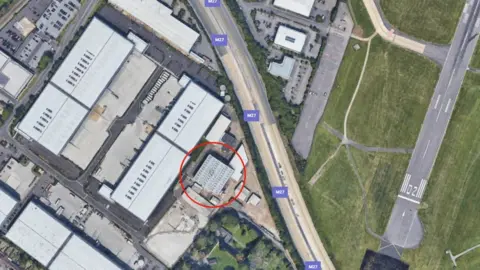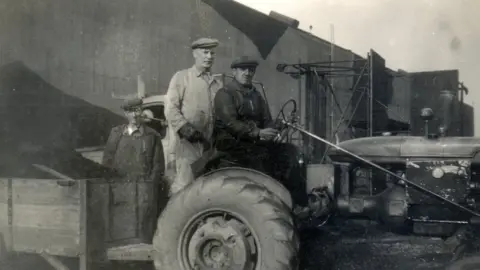Southampton Spitfire Flight Shed: Building set for demolition
 Google
GoogleA building used to test wartime Spitfires is to be demolished, despite tens of thousands of people calling for it to be preserved.
The Flight Shed, on an industrial site near Southampton Airport, was later used by the Ford Transit factory.
More than 50,000 people have signed a petition opposing its demolition.
Southampton City Council approved plans for the site's redevelopment after the shed was deemed to have been modified too much to merit listed status.
After the main Supermarine factory in Southampton was bombed during World War Two, production was moved to smaller factories and workshops across the city and beyond.
The building, near Wide Lane, was used for final checking of completed Spitfires before they were delivered to the RAF.
The Spitfire Makers Charitable Trust is campaigning for 40 production sites in Southampton to be recognised with blue plaques.
 Alan Matlock
Alan MatlockSpeaking at a city council planning meeting, the trust's chairman Alan Matlock called for the demolition plan to be halted "to raise awareness of its significance", according to the Local Democracy Reporting Service.
James Hicks, speaking on behalf Carbide Properties Limited, which tabled the plans, said: "The advice is that it is not suitable for listing. The building has been extensively modified."
The redevelopment of the site would see four new industrial units and create up to 257 new jobs, he added.
A planning officer told councillors the Spitfire was "important to the people of Southampton and nationally".
But he added that planners have to consider the application "as it stands" and stressed that the building was not listed.
The planning panel voted in favour of the proposals and approved conditions asking for the installation of panels illustrating the history of the site.
After the meeting Mr Matlock said it would be a "huge huge loss to the city".
He added: "It means that the most significant connection and physical building that Southampton has with the Spitfire will be lost."

The Supermarine Spitfire
 Press Association
Press Association- The Spitfire was designed by Reginald Mitchell at the Supermarine factory in Woolston, Southampton
- The prototype was first flown from Eastleigh Aerodrome, now Southampton Airport, on 6 March 1936
- After Mitchell died in 1937, his successor Joe Smith developed the fighter to make it faster and more powerful
- The aircraft entered service in 1938 with the RAF, which initially ordered 310 of them from the Woolston works
- The site was bombed in 1940 at a time when most Spitfire manufacturing was being switched to a more modern production line at Castle Bromwich, near Birmingham
- Spitfires shot down a total of 529 enemy aircraft, for a loss of 230 of their own

Follow BBC South on Facebook, Twitter, or Instagram. Send your story ideas to [email protected].
